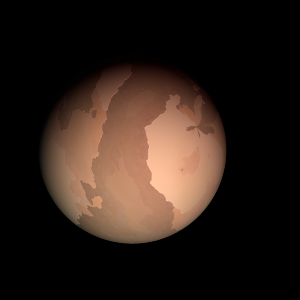|
|
Space Astro
|
Info for exoplanet "Wasyinx"
| Scientific (actual) data |
|---|
| Name | Kepler-312 c |
| Planet status | Confirmed |
| Radius | 0.281 |
| Orbital period | 19.7474 |
| Semi major axis | 0.153 |
| Discovered | 2014 |
| Updated | 2021-02-05 |
| Tconj | 2454980 |
| Impact parameter | 0.18 |
| Publication | Announced on a website |
| Detection type | Primary Transit |
| Alternate names | 2MASS J19533498+4227351 c, K01628.01, KIC 6975129 c, KOI-1628 c, KOI-1628.01, WISE J195334.98+422735.1 c |
| Star name | Kepler-312 |
| Right ascension | 298.4° |
| Declination | 42.46° |
| Mag j | 11.902 |
| Mag h | 11.664 |
| Mag k | 11.596 |
| Star distance | 816.22 |
| Star metallicity | 0.076 |
| Star mass | 1.23 |
| Star radius | 1.47 |
| Star temperature | 6115 |
| Star alternate names | 2MASS J19533498+4227351, KIC 6975129, KOI-1628, WISE J195334.98+422735.1 |
| Wikipedia article | Kepler-312 c |
Back
| |
| Fictional info (?) |
|---|
| Suggested name | Wasyinx |
| Planet type | Terrestrial |
| The planet telescopically displays the complete range of phases, similar to Venus and the Moon, as it moves in its inner orbit relative to Kepler-312, which reoccurs over the so-called synodic period approximately every 180 days.
It has the densest atmosphere of any terrestrials, consisting mostly of sulfur dioxide.
The outer atmosphere is visibly segregated into several bands at different latitudes, resulting in turbulence and storms along their interacting boundaries. |
| Atmosphere | Sulfur dioxide | 70% |
| Formaldehyde | 29% |
| Xenon | 0.21% |
| Hydrogen chloride | 0.11% |
| Ammonium hydrosulfide (NH4SH) | 0.004% |
| Atmospheric pressure | 0.16 bar |
 |
| No known satellites |
| Google search for Wasyinx |
|
Website by Joachim Michaelis
|
|
|
|